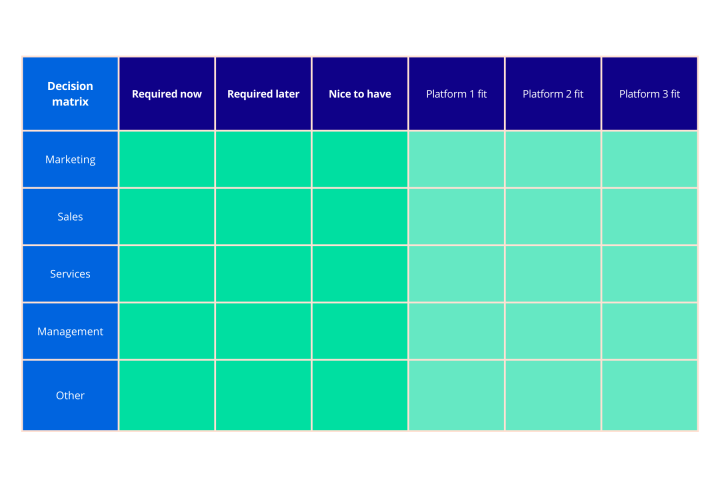How to lay the foundation for marketing automation success
If you’re running a business or leading a marketing team, you may be thinking about automating your marketing and/or operations. If you’re undecided, our blog about why investing in automation should be a priority can be helpful.
For now, let’s say you have decided you need to start implementing automation. There is a lot that automation can do for you, and therefore there is also a lot that can go wrong during implementation as well as afterwards. So here is how you lay the foundation of marketing automation success.
Get buy-in from your employees
As with any software, getting buy-in from the people who need to work with it is crucial. Getting them to work with something they are not behind is just simply not going to happen. Get them on board, make it clear what the benefits are for them. If you don’t, you’re just going to buy something and not use it, which by definition is expensive, no matter how much you pay for it.
And by the way, we don’t mean just the management team, or just the marketeers in your company. We mean everyone who at some point has contact with any of your customers. That includes sales and service people as well. Trust me, you will want them to start using the data in the platform at some point. And without getting their buy-in, it’s kind of pointless.
Now, HOW you get that buy-in is a different story, and completely up to you. But you’ll need to bring them into the process from the beginning.First of all, they may have very hands-on information that can help you decide on the right platform, or the right account level if you have already chosen. Second, it gives them the chance to voice their objections. Your management needs this information, so it can decide on how to tackle the objections. Often, there’s mostly a lot of uncertainty, and by bringing this up early on, you can make the appropriate decisions beforehand, and maybe train people where necessary.
Take your time
We know, the show must go on, your business has targets and deadlines. But still it’s a bad idea to rush into something you don’t know.
So, take enough time to implement automation. As we already pointed out, you need some buy-in. But there is more:
- you need time to look into some options
- you may want to do some demo’s or even set up a few test accounts and play around with it
- you need to gather feedback from your internal stakeholders
- your finance team will want to check the financial feasibility
- perhaps you need to convince stakeholders or a holding company for example
All of these steps take time, and it’s important to take these steps before actually getting started with implementation. This may impact the timing, the budget you can spend or the scale at which you want to set up an automation platform.
We promise it’s worth taking the time though: you’ll get a much clearer idea of what you want to accomplish and how to set everything up, so once you get started, you’ll soon see the ROI from your investment.
Look at the long term
Automation is not something you do for a few months, or to use every now and then. It takes time to set it up, and it takes a financial investment as well.
Also, whenever you invest in marketing, the goal is to grow, in revenue, geographically, in terms of profit or people, whatever the case may be. And even if you don’t invest that much in marketing, there are market conditions, laws and so on to consider. All of this has an effect on your business you can’t ignore.
So if you want to make your automation platform work for you, you need to look at the long term. Some questions you can ask yourself:
- Where do we want to be 3 or 5 years from now?
- What are some impactful trends in your industry?
- What is your competition doing?
By the way: this doesn’t mean you need to choose the highest account level. You can start small and upgrade later. But starting on the right platform will allow you to do that smoothly, without having to start all over in a new system.
Choose the right platform
So far we talked about some factors that have an impact on the platform you will eventually choose. But there is more to consider if you want to make the right choice.
In terms of marketing, you’ll need to map out who is doing marketing for your organization, and what marketing actions they are doing. Don’t forget to include freelancers or external partners here: they might need access too. Next to that, you also need to know what systems you are currently using and what systems you’ll need to connect. Once you get a clear view of this, you can start checking whether all of that is possible or not, and whether it’s a problem in case it’s not possible.
For sales, you’ll want to check what information they need from marketing, how both are aligned and if that should change or not. You’ll also need to know how many people need access and what exactly they should do. It’s also important to have a documented sales process.
For your service people, it’s important to know what interactions they are likely going to have with customers and what information they will need. What is their interaction with sales, and with customers?
And your management team may also have some requirements for a new automation platform. There is of course the cost of the software and implementation, and the time you need to start getting results. Next to that, they may also have some reporting requirements. Your management team also looks at the longer term more than anyone, so they may also have some requirements for the future that you also need to consider beforehand.
A decision matrix like the one below (this is a very simple version) can help you map out what you need and what platform fulfills your requirements to what degree.

Focus on change management
Implementing an automation platform means that you are changing the way people work. The software itself is almost never the biggest change. Sure, it can take some setting up, creating the account, and migrating data for example. But this is relatively easy to do.
The biggest change is in your people. They will need to work in different systems, change some habits and maybe even adapt processes to do their jobs. And yes, that’s also the case when their jobs become easier. Companies usually digitalize their work or implement systems to make jobs easier. So when your people complain that marketing automation will make their jobs harder, that’s not actually true. It just means they are afraid of change, that’s how us humans are.
So focus on the change management within your organization. If you did the previous steps well, you already go their buy-in, and change should be easier, but it’s still necessary. So pay attention to any comments from your people. Listen carefully to their worries work with it. Based on what people tell you, you’ll be able to filter out real issues with your automation platform and start looking for solutions. This is also a good basis for user training, something we absolutely recommend whenever you start using something new.
As you start implementing your automation platform, you may have to make some changes to your existing marketing or sales processes. These will likely be minor changes or optimizations of your current processes, so these will have no impact at all or a positive one on your organization.
User adoption
In the end, the success of any tool or platform is defined by how many people in your team actually use it, and how much of it they use. User adoption is a key factor. Onboarding your users is more than just creating an account for them:
- Train users on the platform
- Make sure to document your processes so users can find it and follow the necessary steps
- Inform your team of important updates
- Clearly define roles for each member in the team
- Review regularly and adjust when needed
LexisNexis University reports that 83% of senior executives said that getting their staff to use the platform is their biggest challenge. And that corresponds with what we have seen so far.
Yes, getting your team to use a certain platform takes time and energy, but when they actually DO start using it to its full potential, the rewards are huge: more efficient use of the tools, happier and more confident users and a higher ROI. And in the end, that’s what this type of platform is all about, right?
Now it’s up to you. Get started on getting buy-in and selecting the right platform for your organization. Don’t hesitate to consult specialists to answer any of your questions, so you can take a well informed decision. And like we said: don’t forget to onboard your team, and work on change management, it makes all the difference. You can find a lot more in our Ultimate Automation Guide. Soon you will be reaping the benefits and start seeing a clear ROI.
Get more marketing insights
Thank you for being here and reading our blog. If you want to get more marketing insights and invitations for events, then don’t hesitate and register for our email updates.






